Voyager is a one of a kind vehicle. Built specifically for the Cross Country Tour, it's design to withstand the rigors of the trip.
The airframe for the Voyager was sponsored by Phoenix Powered Parachutes, and has proven to be an excellent machine. Using the standard Liberty frame, Phoenix modified it to accept an HKS engine, and has tweaked it to maximize performance, such as raising the riser attachment bars about 14 inches.
The Voyager has endured extreme conditions while flying through the Rocky Mountains, including punishing "short field" landings and turbulence exerting tremendous stress on the frame. Through all of this Voyager has performed beyond all expectations.
Let's take a closer look at the craft that is bringing The Red Baron safely home.
| The chute bag is sitting in the rear seat. The voyager has full dual controls. And yes, that is a megaphone. | 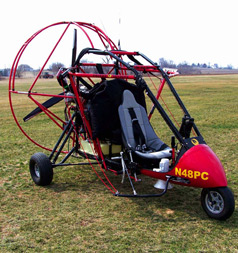 |
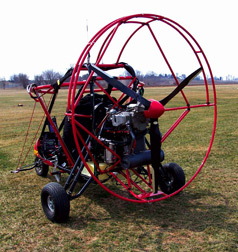 | If you're thinking that's a large rop, you're right... it's 72 inches! The two antenna are for the radio and the ELT. |
Voyager is the first PPC designed for cross-country flight. The large color display moving-map GPS, containing the complete Jensen database, make navigation accurate and easy.
Other features include a Grand Rapids EIS, an electric fuel pump to back up the impulse fuel pump, Vertex radio, fuel mixture control, MicroTim altimiter and a Garmin Mode C transponder. | 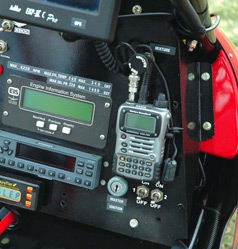 |
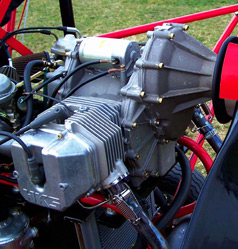 | That big prop is powered by an HKS 700E 4 stroke engine. You'll note, behind the rear seat, an 8 gallon fuel tank. Combined with the 10 gallon tank under the seat, Voyager has an 18 gallon capacity which translates into a minimum of 5 hours in the air with a 1 hour reserve. (And that's assuming a 3 gallon per hour burn rate. It's actually lower than that.) |
Yes, that's a tailhook under the back end! (Safety cotterpinned, for when it's not in use.)
If we're landing on the Yorktown, it's best to be prepared for all contingencies. The tailhook drops when a small handle, mounted on the front wheel steering bar, is pulled. | 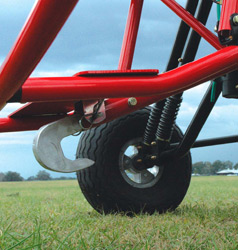 |
Equipment
- Vertex avionic radio system
- Garmin mode C transponder
- Grand Rapids Electronix Instrumentation System
- AvMap color moving map GPS system
- MicroTim Altimeter
- Megaphone
- Tailhook (for carrier landings)
- Artex Emergency Locator System
Specifications
| Dry weight: | 480 pounds |
| Fuselage length: | 10 feet |
| Fuselage width: | 6 feet, 2 inches |
| Fuselage height: | 7 feet, 2 inches |
| Fuel capacity: | 18 gallons |
| Engine: | HKS 700E 60 horsepower 4 stroke |
| Prop: | 72 inch lvo |
| Wing width: | 40 feet (side to side) |
| Wing depth: | 12 feet (front to back) |
| Air speed: | 30 miles per hour |
| Operational ceiling: | 10,000 feet |
| Maximum climb: | 500 feet per minute |
| Maximum flight time: | 5 hours (with 1 hour reserve remaining) |
We're glad to have had help in making Voyager what it is today.
Visit our Wish List to find out more about the sponsors that helped give it life.




